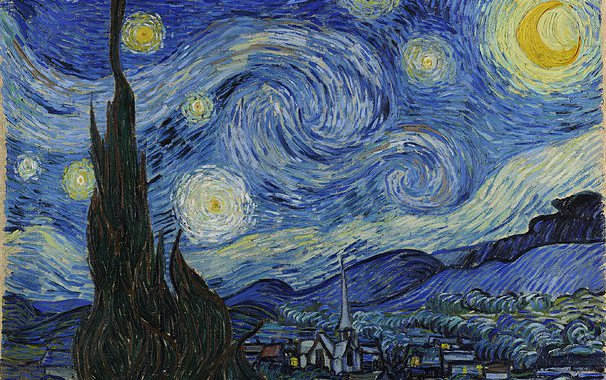Today we have reached the final picture of Landsat week.
I am starting to ask myself if someone at NASA is trying to follow in van Gogh’s footsteps. We have featured a video on ocean currents visualized in a van Gogh’esque fashion. This picture seems very much like the masterpiece ?The Starry Night?.
This picture was recorded above the Baltic sea and shows the Swedish island Gotland. The flora and fauna on this island are very diverse. Especially, birds and orchids are one of the traits of Gotland. However, the geology is in no way inferior showing a beautiful sequence from the Silurian age. That’s about 443.7 to 416 million years ago. It’s a succession of limestone and shale of 200 to 500m thickness. Back when they started building, corals formed the first reefs offshore the continent in a depth of 4m to 50m. Whereas, the shales were deposited in a deep water environment. Common for limestone plateaus, the structure has been karstified. In the south you can find some sandstones that were deposited as the most recent sediments.http://palaeo.uni-hd.de/Thema4.htm abgerufen 20.07.2012
Now what about these swirly structures around Gotland?
Those are phytoplankton blooms. Phytoplankton are the microscopic ?grass of the sea?, serving as a main food source to many marine animals. Just like plants on land, plankton blooms when the temperature is right and nutrients can support the bloom. Phytoplankton can only survive in the very upper part of the water column, where light can still enter. During a bloom the plankton releases chlorophyl, the green pigment that also makes our tree’s leaves green. The chlorophyl becomes an indicator for local water currents.
Let’s all thank the guys NASA for giving us another wonderful piece where art and science connect. Now enjoy the picture, that placed 1st in the big ?Earth as Art? vote: http://amplt.de/l8
We hope you enjoyed the Landsat week!
-JSD
via The Earth Story’s Facebook Wall
Jesper Dramsch
Latest posts by Jesper Dramsch (see all)
- Juneteenth 2020 - 2020-06-19
- All About Dashboards – Friday Faves - 2020-05-22
- Keeping Busy – Friday Faves - 2020-04-24


Se5 inspirerende inelgng! Og se5 spennende at du skal skrive bok om shaping! Den kommer til e5 bli se5 bra! . Du ga meg ogse5 noe e5 tenke pe5 ved formulering av me5l. Det er jo faktisk stor forskjell pe5 e5 skrive at man skal prf8ve eller begynne pe5 noe framfor at man SKAL gjf8re noe!